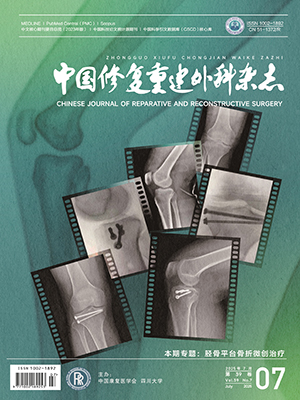| 1. |
Zhao CQ, Jiang LS, Dai LY. Programmed cell death in intervertebral disc degeneration. Apoptosis, 2006, 11(12):2079-2088.
|
| 2. |
Kokubun S, Sakurai M, Tanaka Y. Cartilaginous endplate in cervical disc herniation. Spine (Phila Pa 1976), 1996, 21(2):190-195.
|
| 3. |
Esteban MA, Wang T, Qin B, et al. Vitamin C enhances the generation of mouse and human induced pluripotent stem cells. Cell Stem Cell, 2010, 6(1):71-79.
|
| 4. |
Shi Y, Zhao Y, Deng H. Powering reprogramming with vitamin C. Cell Stem Cell, 2010, 6(1):1-2.
|
| 5. |
Rossig L, Hoffmann J, Hugel B, et al. Vitamin C inhibits endothelial cell apoptosis in congestive heart failure. Circulation, 2001, 104(18):2182-2187.
|
| 6. |
Kluba T, Niemeyer T, Gaissmaier C, et al. Human anulus fibrosis and nucleus pulposus cells of the intervertebral disc:effect of degeneration and culture system on cell phenotype. Spine (Phila Pa 1976), 2005, 30(24):2743-2748.
|
| 7. |
韩成龙, 朱洪勋. 髓核细胞表型标记的研究进展. 中国修复重建外科杂志, 2011, 25(7):867-870.
|
| 8. |
Murata Y, Rydevik B, Nannmark U, et al. Local application of interleukin-6 to the dorsal root ganglion induces tumor necrosis factor-alpha in the dorsal root ganglion and results in apoptosis of the dorsal root ganglion cells. Spine (Phila Pa 1976), 2011, 36(12):926-932.
|
| 9. |
Wei A, Brisby H, Chung SA, et al. Bone morphogenetic protein-7 protects human intervertebral disc cells in vitro from apoptosis. Spine J, 2008, 8(3):466-474.
|
| 10. |
Zhang CC, Zhou JS, Hu JG, et al. Effects of IGF-1 on IL-1beta-induced apoptosis in rabbit nucleus pulposus cells in vitro. Mol Med Rep, 2013, 7(2):441-444.
|
| 11. |
Kawaguchi S, Yamashita T, Katahira G, et al. Chemokine profile of herniated intervertebal discs infilltrated with monocytes and macrophages. Spine (Phila Pa 1976), 2002, 27(14):1511-1516.
|
| 12. |
Valdes AM, Hassett G, Hart DJ, et al. Radiographic progression of lumbar spine disc degeneration is influenced by variation at inflammatory genes:a candidate SNP association study in the Chingford cohort. Spine (Phila Pa 1976), 2005, 30(21):2445-2451.
|
| 13. |
Nam V, Christopher S, Paulo C, et al. Identification of novel TNF-α regulated extracellular matrix and cell-matrix adhesion genes in intervertebral disc cells:A microarray gene profiling of human nucleus pulposus cells. Spine Society, 2008, 8:99s-100s.
|
| 14. |
Choi KM, Seo YK, Yoon HH, et al. Effect of ascorbic acid on bone marrow-derived mesenchymal stem cell proliferation and differentiation. J Biosci Bioeng, 2008, 105(6):586-594.
|
| 15. |
Nandi D, Patra RC, Swarup D. Effect of cysteine, methionine, ascorbic acid and thiamine on arsenic-induced oxidative stress and biochemical alterations in rats. Toxicology, 2005, 211(1-2):26-35.
|
| 16. |
Clegg HV, Zhang Y. Regulation of the p53 tumor suppressor pathway:the problems and promises of studying Mdm2's E3 ligase function. Crit Rev Eukaryot Gene Expr, 2010, 20(1):77-86.
|
| 17. |
Zhang H, Gu C, Yu J, et al. Radiosensitization of glioma cells by TP53-induced glycolysis and apoptosis regulator knockdown is dependent on thioredoxin-1 nuclear translocation. Free Radic Biol Med, 2014, 69:239-248.
|
| 18. |
Halfter UM, Derbyshire ZE, Vaillancourt RR. Interferon-gamma-dependent tyrosine phosphorylation of MEKK4 via Pyk2 is regulated by annexin Ⅱ and SHP2 in keratinocytes. Biochem J, 2005, 388(Pt 1):17-28.
|
| 19. |
Gerin I, Noël G, Bolsée J, et al. Identification of TP53-induced glycolysis and apoptosis regulator (TIGAR) as the phosphoglycolate-independent 2,3-bisphosphoglycerate phosphatase. Biochem J, 2014, 458(3):439-448.
|
| 20. |
Wanka C, Steinbach JP, Rieger J. Tp53-induced glycolysis and apoptosis regulator (TIGAR) protects glioma cells from starvation-induced cell death by up-regulating respiration and improving cellular redox homeostasis. J Biol Chem, 2012, 287(40):33436-33446.
|
| 21. |
Pan Y, Oprysko PR, Asham AM, et al. p53 cannot be induced by hypoxia alone but responds to the hypoxic microenvironment. Oncogene, 2004, 23(29):4975-4983.
|
| 22. |
Sansome C, Zaika A, Marchenko ND, et al. Hypoxia death stimulus induces translocation of p53 protein to mitochondria. Detection by immunofluorescence on whole cells. FEBS Lett, 2001, 488(3):110-115.
|
| 23. |
An SH, Kang JH, Kim DH, et al. Vitamin C increases the apoptosis via up-regulation p53 during cisplatin treatment in human colon cancer cells. BMB Rep, 2011, 44(3):211-216.
|
| 24. |
Kim J, Lee SD, Chang B, et al. Enhanced antitumor activity of vitamin C via p53 in cancer cells. Free Radic Biol Med, 2012, 53(8):1607-1615.
|
| 25. |
Petak I, Tillman DM, Houghton JA. p53 dependence of Fas induction and acute apoptosis in response to 5-fluorouracil-leucovorin in human colon carcinoma cell lines. Clin Cancer Res, 2000, 6(11):4432-4441.
|
| 26. |
Lee SH, Oe T, Blair IA. Vitamin C-induced decomposition of lipid liydroperoxides to endogenous genotoxins. Science, 2001, 292(5524):2083-2086.
|
| 27. |
曾锦荣, 蒋碧佳, 王绩英. 三氧化二砷联合维生素C对耐药性肺腺癌裸鼠移植瘤Caspase-3、Survivin活性的影响. 中国老年学杂志, 2011, 24(31):4827-4831.
|
| 28. |
Galluzzi L, Morselli E, Kepp O, et al. Defective autophagy control by the p53 rheostat in cancer. Cell Cycle, 2010, 9(2):250-255.
|
| 29. |
Maiuri MC, Galluzzi L, Morselli E, et al. Autophagy regulation by p53. Curr Opin Cell Biol, 2010, 22(2):181-185.
|
| 30. |
Ascher E, Scheinman M, Hingorani A, et al. Effect of p53 gene therapy combined with CTLA4Ig selective immunosuppression on prolonged neointima formation reduction in a rat model. Ann Vasc Surg, 2000, 14(4):385-392.
|
| 31. |
迟立群, 李功宋, 高长青, 等. 野生型p53基因转染和低能量激光照射防治移植静脉再狭窄的实验研究. 中华胸心血管外科杂志, 2003, 19(1):50-53.
|
| 32. |
Bouvet M, Ellis LM, Nishizaki M, et al. Adenovirus-mediated wild-type p53 gene transfer down-regulates vascular endothelial growth factor expression and inhibits angiogenesis in human colon cancer. Cancer Res, 1998, 58(11):2288-2292.
|
| 33. |
Xue Y, Li NL, Yang JY, et al. Phosphatidylinositol 3'-kinase signaling pathway is essential for Rac1-induced hypoxia-inducible factor-1(alpha) and vascular endothelial growth factor expression. Am J Physiol Heart Circ Physiol, 2011, 300(6):H2169-2176.
|
| 34. |
Qin G, Kishore R, Dolan CM, et al. Cell cycle regulator E2F1 modulates angiogenesis via p53-dependent transcriptional control of VEGF. Proc Natl Acad Sci U S A, 2006, 103(29):11015-11020.
|




